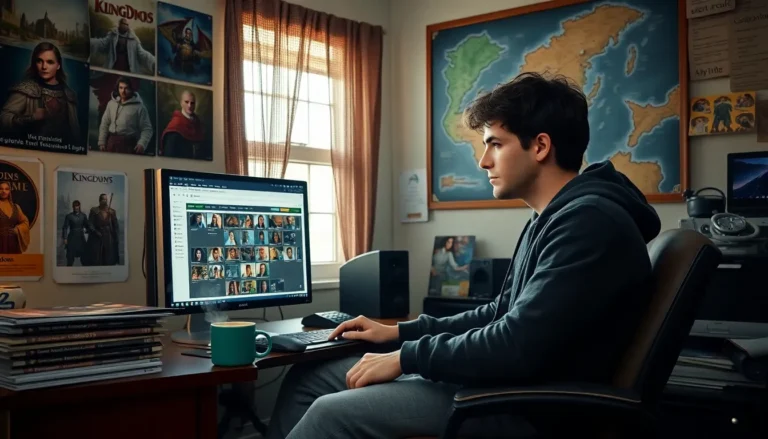Table of Contents
ToggleThe Nintendo Wii Remote, affectionately dubbed the “Wiimote,” is a little piece of magic that revolutionized gaming. Picture this: a device that allows players to swing a virtual tennis racket or shake a controller like it’s a maraca. Sounds fun, right? But what’s truly fascinating is how this unique gadget transformed the gaming landscape forever. Strap in as we dig into the history, innovations, and more behind this iconic controller.
History of the Nintendo Wii Remote

Unveiled in 2006 alongside the Nintendo Wii console, the Wii Remote marked a daring leap into the world of motion-sensing gaming. This innovation stemmed from Nintendo’s desire to create a gaming experience that was not only entertaining but also accessible to all ages. The company aimed to bridge the gap between casual and hardcore gamers, and boy, did they succeed.
The early prototypes showcased basic motion sensing and aimed for an intuitive design that could appeal to the masses. When the Wiimote finally hit the shelves, it wasn’t just about playing games: it became a social phenomenon. Families were dancing, bowling, and boxing together in their living rooms, breaking the traditional notion of what gaming could be.
As sales soared, Nintendo solidified the Wii Remote’s place in history. By 2013, they had sold over 100 million units, establishing it as a leader in the controller market. History lessons might usually put you to sleep, but the story of the Wii Remote is anything but dull.
Key Features and Innovations
What makes the Wii Remote stand out in a sea of controllers? First and foremost, it boasts integrated motion sensing technology. This isn’t just any average controller: it captures the player’s movements and translates them into the game. Imagine swinging a baseball bat or driving a car just by tilting or swinging your controller.
Another standout feature is the built-in speaker. It adds an extra layer of immersion as players can hear in-game sounds or audio cues directly from the remote. No more echoing sounds bouncing off your walls. Battery life is another consideration. The Wii Remote operates on standard AA batteries, providing substantial playtime.
Besides, the device comes equipped with a strap that ensures players won’t accidentally launch their remote through the TV screen during exciting moments. Let’s not overlook the Wii MotionPlus attachment, which enhances accuracy significantly. With these distinct features, it’s clear why the Wii Remote remains beloved by gamers young and old.
How to Set Up Your Wii Remote
Getting started with your Wii Remote is as easy as pie, if pie was a motion-sensing controller, that is. First, make sure your console is powered on and locate your Wii Remote. For setup, you’ll need a fresh pair of AA batteries: it’s always wise to check that your remote is ready to go.
- Insert Batteries: Open the battery cover on the back of the remote, insert the batteries, and close the cover securely.
- Sync the Remote: Press the red SYNC button on the Wii console. Then press the red SYNC button located in the battery compartment of the Wii Remote. If done correctly, the player LED lights on the remote will illuminate, indicating a successful connection.
- Use the Sensor Bar: Ensure your sensor bar is positioned correctly, either atop or below your TV. This bar tracks the movement of your Wii Remote, so its positioning is crucial for a smooth gaming experience.
- Testing: Navigate the Wii menu using the pointer feature to confirm the remote is working as intended. If all goes well, you’re ready to jump into gameplay.
With just a few simple steps, you can set up your Wii Remote and get to gaming. It’s almost like magic, no wand required.
Popular Games Utilized with the Wii Remote
The Wii Remote isn’t just a fancy gadget: it opened the door to an array of fantastic games. One of the hallmark titles, Wii Sports, showcased the remote’s capabilities beautifully. Players could swing, pitch, and bowl, making it a staple at gatherings and family events.
Another fan-favorite is Mario Kart Wii. Who doesn’t love zooming around Rainbow Road while clutching their Wii Remote? This title perfectly utilizes the remote’s steering functionality, adding layers of fun and competitiveness.
For those seeking a brain workout, Big Brain Academy: Wii Degree takes the cake. The combination of thought-provoking challenges and the remote’s intuitive controls makes for an engaging experience.
Finally, let’s give a nod to Just Dance, a game that turned living rooms into dance floors. Players wave their remotes around like seasoned dancers, showcasing their moves (or lack thereof) in front of family and friends. This game alone has birthed a new generation of self-proclaimed dancers everywhere.
Troubleshooting Common Issues
Even the best gadgets have their quirks. If you encounter issues with your Wii Remote, fear not. Here are some common problems and how to address them:
- Remote Won’t Sync: If your remote fails to sync, check the batteries first. If they’re fresh, try re-syncing by following the steps noted earlier.
- Unresponsive Buttons: Have you ever experienced a button sticking? Sometimes, after hours of play, crumbs from snacks and drinks could hinder the buttons. Cleaning the remote with a soft, dry cloth might just do the trick.
- Tracking Issues: Occasionally, the cursor may not respond as expected. This might be due to interference from bright lights or other electronic devices. Reducing ambient light can improve the remote’s efficiency.
Should these tips not solve your problems, reaching out to Nintendo’s customer service may lead you to a professional solution. Don’t let a little hiccup ruin your gaming experience.
The Legacy and Impact of the Wii Remote
The impact of the Wii Remote transcends beyond just gaming: it effectively reshaped how people view interactive entertainment. It encouraged physical activity in gaming, something not traditionally associated with video games.
The emphasis on motion control paved the way for subsequent consoles and innovations. For instance, PlayStation and Xbox soon altered their controllers, incorporating motion-sensing technology as well. With the advent of virtual reality, the foundation laid by the Wii Remote has been incredibly influential.
Also, the social environment created by games utilizing the Wiimote has helped develop a more inclusive gaming culture. The rise of casual gaming can be traced back to the success of this little contraption. Family game nights no longer feel exclusive to hardcore gamers: instead, they invite everyone to join in on the fun.






